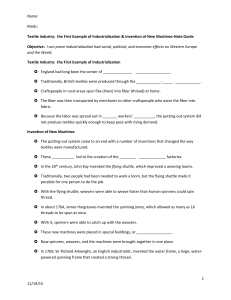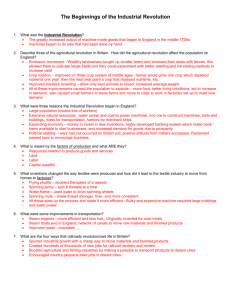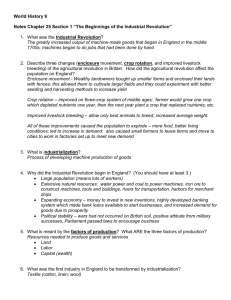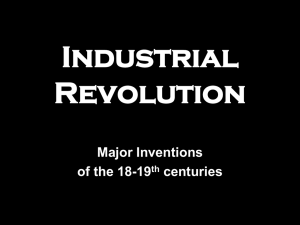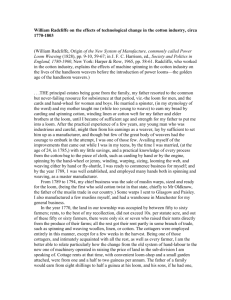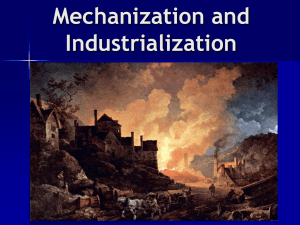Ch25SAWTACCHARTReading2015
advertisement
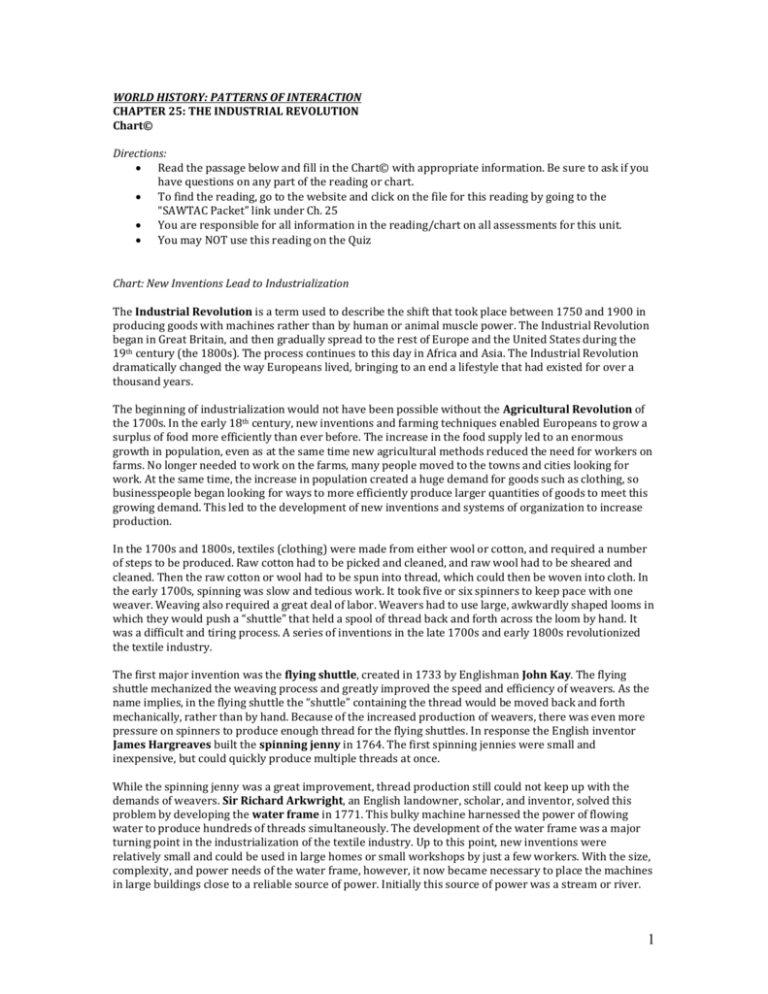
WORLD HISTORY: PATTERNS OF INTERACTION CHAPTER 25: THE INDUSTRIAL REVOLUTION Chart© Directions: Read the passage below and fill in the Chart© with appropriate information. Be sure to ask if you have questions on any part of the reading or chart. To find the reading, go to the website and click on the file for this reading by going to the “SAWTAC Packet” link under Ch. 25 You are responsible for all information in the reading/chart on all assessments for this unit. You may NOT use this reading on the Quiz Chart: New Inventions Lead to Industrialization The Industrial Revolution is a term used to describe the shift that took place between 1750 and 1900 in producing goods with machines rather than by human or animal muscle power. The Industrial Revolution began in Great Britain, and then gradually spread to the rest of Europe and the United States during the 19th century (the 1800s). The process continues to this day in Africa and Asia. The Industrial Revolution dramatically changed the way Europeans lived, bringing to an end a lifestyle that had existed for over a thousand years. The beginning of industrialization would not have been possible without the Agricultural Revolution of the 1700s. In the early 18th century, new inventions and farming techniques enabled Europeans to grow a surplus of food more efficiently than ever before. The increase in the food supply led to an enormous growth in population, even as at the same time new agricultural methods reduced the need for workers on farms. No longer needed to work on the farms, many people moved to the towns and cities looking for work. At the same time, the increase in population created a huge demand for goods such as clothing, so businesspeople began looking for ways to more efficiently produce larger quantities of goods to meet this growing demand. This led to the development of new inventions and systems of organization to increase production. In the 1700s and 1800s, textiles (clothing) were made from either wool or cotton, and required a number of steps to be produced. Raw cotton had to be picked and cleaned, and raw wool had to be sheared and cleaned. Then the raw cotton or wool had to be spun into thread, which could then be woven into cloth. In the early 1700s, spinning was slow and tedious work. It took five or six spinners to keep pace with one weaver. Weaving also required a great deal of labor. Weavers had to use large, awkwardly shaped looms in which they would push a “shuttle” that held a spool of thread back and forth across the loom by hand. It was a difficult and tiring process. A series of inventions in the late 1700s and early 1800s revolutionized the textile industry. The first major invention was the flying shuttle, created in 1733 by Englishman John Kay. The flying shuttle mechanized the weaving process and greatly improved the speed and efficiency of weavers. As the name implies, in the flying shuttle the “shuttle” containing the thread would be moved back and forth mechanically, rather than by hand. Because of the increased production of weavers, there was even more pressure on spinners to produce enough thread for the flying shuttles. In response the English inventor James Hargreaves built the spinning jenny in 1764. The first spinning jennies were small and inexpensive, but could quickly produce multiple threads at once. While the spinning jenny was a great improvement, thread production still could not keep up with the demands of weavers. Sir Richard Arkwright, an English landowner, scholar, and inventor, solved this problem by developing the water frame in 1771. This bulky machine harnessed the power of flowing water to produce hundreds of threads simultaneously. The development of the water frame was a major turning point in the industrialization of the textile industry. Up to this point, new inventions were relatively small and could be used in large homes or small workshops by just a few workers. With the size, complexity, and power needs of the water frame, however, it now became necessary to place the machines in large buildings close to a reliable source of power. Initially this source of power was a stream or river. 1 These new buildings became the first factories, and as new inventions were adopted and demand for textiles grew, the factories would expand until they employed thousands of workers and produced tens of thousands of pounds of clothing for sale all around the world. Spinning got another boost in 1779 when an English weaver named Samuel Crompton combined the best features of the spinning jenny with the water frame to create the spinning mule. The spinning mule could not only quickly produce large quantities of thread, but the thread made by this machine was much stronger and more durable. As a result of the water frame and spinning mule, weavers could now no longer keep pace with the production of thread. In response, an eccentric English poet and clergyman named Edmund Cartwright built the power loom in 1785. Using the force of flowing water, the power loom could rapidly and automatically weave thread, greatly increasing the production of finished cloth. Like the water frame, the power loom was large and complicated and had to be located in a large factory near a source of running water. Businessmen could now place spinning mules and power looms together in one factory near a stream or river and completely mechanize the entire spinning and weaving process. The advances in spinning and weaving created a massive increase in demand for raw cotton. By the end of the 1700s, cotton brought from the Americas and India had become the major raw material used in the production of textiles. Cotton had to be picked by hand, however, and painstakingly cleaned and prepared. This slowed down the production of raw cotton. In 1793, an American inventor named Eli Whitney built a cotton gin, which quickly and mechanically separated the seeds from the cotton fiber. As a result of Whitney’s invention, much more raw cotton became available to be spun into thread and woven into cloth. The new inventions that increased productivity in the textile industry depended on running water to supply power. Factory-owners wanted to find a source of power that would enable them to build their factories anywhere, especially closer to ports and raw materials so as to reduce costs. The development of steam power would make this possible, and further transform European society. The first functional steam engine was built in 1725 by the Englishman Thomas Newcomen, an industrious inventor who had developed the device to more efficiently remove water from flooded coal mines. A brilliant Scottish professor and engineer named James Watt recognized the incredible potential of Newcomen’s work. In 1769, Watt built an improved version of the steam engine that used less fuel, was more efficient, and could be easily adapted for a variety of uses. Watt’s engine paved the way for the age of steam power. The steam engine was first adapted to transportation. In 1807 the American inventor Robert Fulton used a steam engine to power a river-boat: the first steamship. Steamships greatly reduced the time and cost of transportation, thereby reducing the cost of both producing and purchasing goods. The most important and influential adaptation of the steam engine was the steam-powered locomotive. The steam locomotive grew out of the need to transport coal from deep mines to the surface more quickly, safely, and efficiently. His experience in the coal of mines of central England helped inventor George Stephenson build the first functional steam locomotive in 1829, based on designs he had developed in the early 1800s. Although his first locomotive was slow and used a lot of fuel, over time the locomotive was quickly improved and was able to rapidly and efficiently transport large quantities of material over land. Furthermore, the railroads themselves required large amounts of iron, steel, and coal to be built, which further boosted those industries. The new inventions of the Industrial Revolution dramatically increased efficiency and reduced the cost of items, enabling more and more people to purchase goods. As a result of these new innovations, the standard of living for all Westerners gradually improved over the course of the 1800s and 1900s. 2


